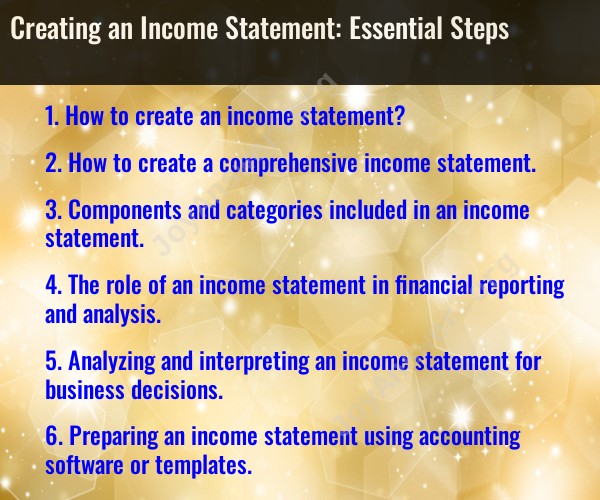How to create an income statement?
Creating an income statement, also known as a profit and loss statement (P&L), is essential for tracking the financial performance of a business over a specific period. It summarizes a company's revenues, costs, and expenses to determine its profitability. Here are the essential steps to create an income statement:
Step 1: Gather Financial Data
Collect all the financial data you need for the period you're analyzing. This includes records of revenues, sales, and various expense categories, such as cost of goods sold, operating expenses, and interest expenses.
Step 2: Define the Reporting Period
Determine the time frame for which you want to create the income statement. Typically, income statements cover a monthly, quarterly, or annual period. The reporting period should be consistent with other financial reports.
Step 3: Organize Revenue Sources
List all sources of revenue, such as product sales, service income, interest income, and any other income streams. Make sure to report each category separately.
Step 4: Calculate Gross Profit
Subtract the cost of goods sold (COGS) from the total revenue to calculate the gross profit. COGS includes the direct costs associated with producing or delivering the goods or services sold.
Step 5: List Operating Expenses
Separately list and categorize all operating expenses. Common operating expenses include salaries, rent, utilities, marketing expenses, insurance, and depreciation. Make sure to itemize each expense category.
Step 6: Calculate Operating Income
Subtract the total operating expenses from the gross profit to calculate the operating income (also known as operating profit or operating margin). This figure represents the company's profitability before interest and taxes.
Step 7: Include Interest and Other Income/Expenses
If applicable, include interest income and interest expenses. Additionally, account for any other income or expenses not covered in the operating income section. These may include investment income, gains or losses from the sale of assets, or other non-operating items.
Step 8: Calculate Pre-Tax Income
Subtract interest expenses and other non-operating expenses from the operating income to determine the pre-tax income.
Step 9: Account for Taxes
Calculate the income tax expense. This figure represents the income taxes the company owes based on the pre-tax income. Tax rates and regulations may vary by location and business structure.
Step 10: Calculate Net Income
Subtract the income tax expense from the pre-tax income to calculate the net income (or net profit) for the period. This is the final figure on the income statement and represents the company's profit after all expenses and taxes.
Step 11: Review and Format
Review the income statement to ensure accuracy and completeness. Organize the data in a clear and understandable format, usually with revenues at the top, followed by expenses, and ending with the net income figure at the bottom.
Step 12: Analyze and Interpret
Once the income statement is created, analyze the results. Compare the current income statement with previous periods to assess trends and make informed financial decisions.
Creating an income statement is an essential part of financial reporting for businesses, helping stakeholders understand the company's financial performance over a specific period. It's also a valuable tool for budgeting and planning future financial strategies.
How to create a comprehensive income statement
An income statement, also known as a profit and loss (P&L) statement, is a financial statement that shows a company's revenues and expenses over a period of time. It is one of the three most important financial statements, along with the balance sheet and cash flow statement.
To create a comprehensive income statement, you will need to gather the following information:
- Revenue: This includes all of the money that the company has generated from its core business activities.
- Expenses: This includes all of the money that the company has spent to generate revenue, such as cost of goods sold, operating expenses, and interest expenses.
- Income taxes: This includes the amount of income taxes that the company owes on its profits.
Once you have gathered this information, you can start to create your income statement. The following is a basic outline of an income statement:
Revenue
- Sales
- Other income
Expenses
- Cost of goods sold
- Operating expenses
- Interest expenses
- Income taxes
Net income
The net income is the bottom line of the income statement and it represents the company's profit for the period.
Components and categories included in an income statement
The following are the main components and categories included in an income statement:
Revenue
Revenue is the money that a company generates from its core business activities. The main categories of revenue include:
- Sales of goods or services
- Interest income
- Dividend income
- Rental income
Expenses
Expenses are the costs that a company incurs in order to generate revenue. The main categories of expenses include:
- Cost of goods sold
- Operating expenses
- Interest expenses
- Income taxes
Cost of goods sold
The cost of goods sold is the direct cost of producing the goods or services that the company sells. This includes the cost of raw materials, labor, and manufacturing overhead.
Operating expenses
Operating expenses are the costs that a company incurs in order to run its business on a day-to-day basis. This includes the cost of marketing, advertising, salaries, and rent.
Interest expenses
Interest expenses are the costs that a company incurs on its debt. This includes the cost of interest on loans and bonds.
Income taxes
Income taxes are the taxes that a company owes on its profits.
The role of an income statement in financial reporting and analysis
The income statement is one of the most important financial statements because it shows a company's profitability. It is used by investors, creditors, and other stakeholders to assess the company's financial performance and make informed decisions.
Analyzing and interpreting an income statement for business decisions
The income statement can be used to analyze a company's financial performance in a number of ways. For example, you can use the income statement to:
- Calculate the company's profit margin
- Identify the company's most profitable products or services
- Track the company's revenue and expenses over time
- Compare the company's financial performance to its competitors
Preparing an income statement using accounting software or templates
There are a number of accounting software programs and templates that can be used to prepare an income statement. These programs and templates can make it easier to create an accurate and complete income statement.
If you are new to accounting or financial reporting, it is a good idea to seek the advice of a qualified accountant or financial advisor. They can help you to understand the income statement and how to use it to make informed business decisions.
Overall, the income statement is a valuable tool for financial reporting and analysis. By understanding the income statement and how to use it, you can make informed decisions about your business.













